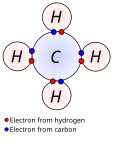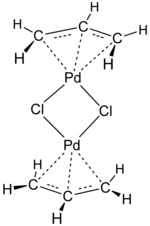The 18-electron rule is a chemical rule of thumb used primarily for predicting and rationalizing formulas for stable transition metal complexes, especially...
17 KB (1,923 words) - 02:05, 19 June 2024
octet rule is a chemical rule of thumb that reflects the theory that main-group elements tend to bond in such a way that each atom has eight electrons in...
22 KB (2,870 words) - 20:18, 28 October 2024
and oxygen, 18-electron rule in inorganic chemistry and organometallic chemistry of transition metals, Hückel's rule for the π-electrons of aromatic compounds...
14 KB (1,629 words) - 12:44, 22 September 2024
Aufbau principle (redirect from Principles in distribution of electrons)
'building-up principle'), also called the Aufbau rule, states that in the ground state of an atom or ion, electrons first fill subshells of the lowest available...
28 KB (3,070 words) - 11:23, 8 November 2024
This tendency is called the 18-electron rule, because each bonded atom has 18 valence electrons including shared electrons. The heavy group 2 elements...
24 KB (2,333 words) - 14:12, 27 October 2024
shell diagrams. Periodic table (electron configurations) Electron counting 18-electron rule Core charge Re: Why do electron shells have set limits ? madsci...
28 KB (2,778 words) - 20:59, 1 November 2024
In atomic physics and quantum chemistry, the electron configuration is the distribution of electrons of an atom or molecule (or other physical structure)...
60 KB (6,147 words) - 17:51, 19 November 2024
Tolman's rule states that, in a certain chemical reaction, the steps involve exclusively intermediates of 18- and 16 electron configuration. The rule is an...
2 KB (158 words) - 15:27, 11 October 2022
the atomic number of argon. Group 18 of the periodic table is called the noble gases. The 18-electron rule is a rule of thumb in transition metal chemistry...
7 KB (891 words) - 00:52, 4 November 2024
rule, the 18-electron rule, and Hückel's 4n + 2 pi-electron rule are proven to be useful in predicting the molecular stability. Wade's rules were formulated...
14 KB (1,581 words) - 12:51, 25 September 2023
Most species with the formula Mx(CO)y follow the 18-electron rule, whereas V(CO)6 has 17 valence electrons. According to the original synthesis by Calderazzo...
5 KB (431 words) - 12:44, 21 July 2024
are used below. As an approximate rule, electron configurations are given by the Aufbau principle and the Madelung rule. However there are numerous exceptions;...
58 KB (1,187 words) - 13:22, 20 May 2024
orbital of the ligand. Bridging carbonyl Dewar–Chatt–Duncanson model 18-electron rule Ligand field theory Pi-donor ligands Miessler, Gary L.; Tarr, Donald...
11 KB (1,291 words) - 04:15, 18 October 2024
are the five d, one s and three p orbitals with the corresponding 18-electron rule, spxdy hybridisation is used to model the shape of these molecules...
33 KB (3,170 words) - 15:02, 7 November 2024
bonding in transition metal carbonyl complexes which abide by the 18-electron rule, and others arguing the molecule more accurately contains ionic bonds...
22 KB (2,573 words) - 19:43, 6 February 2024
organic chemistry, Hückel's rule predicts that a planar ring molecule will have aromatic properties if it has 4n + 2 π-electrons, where n is a non-negative...
13 KB (1,586 words) - 18:06, 25 November 2024
be found using the 18-electron rule, saying that the valence shells of a transition metal will collectively accommodate 18 electrons, whereas the symmetry...
66 KB (8,043 words) - 01:08, 14 October 2024
In solid-state physics, the electron mobility characterises how quickly an electron can move through a metal or semiconductor when pushed or pulled by...
51 KB (7,202 words) - 18:45, 21 September 2024
enforced by the 18-electron rule, since CpFe(CO)2(η1-C3H5) is already an 18-electron complex, while an η3-allyl ligand would result in an electron count of 20...
13 KB (1,500 words) - 18:49, 17 November 2024
(oxidation state zero) and [Fe(CO) 4]2− (oxidation state −2) in which the 18-electron rule is obeyed. These complexes are also covalent. Ionic compounds are mostly...
40 KB (4,504 words) - 06:11, 16 October 2024
creating a very stable complex, which satisfies the 18-electron rule. The cis-labilization of 18 e− complexes suggests that dissociation of ligand X in...
9 KB (1,053 words) - 14:45, 17 November 2024
reinforce fundamental topics in organometallic chemistry like d-electron count, the 18-electron rule, oxidation state, valency, and the isolobal analogy. Many...
43 KB (4,524 words) - 20:12, 26 August 2024
share their electrons. Apparent violations of the 18-electron rule sometimes are explicable in compounds with unusual hapticities: The 18-VE complex...
13 KB (1,321 words) - 20:45, 16 January 2024
with a low-spin 3d6 octahedral Co(III) center. The cation obeys the 18-electron rule and is considered to be a classic example of an exchange inert metal...
8 KB (665 words) - 21:00, 6 August 2024
available. The formulae of many metal carbonyls can be inferred from the 18-electron rule. Group 2 elements calcium, strontium, and barium can all form octacarbonyl...
70 KB (7,931 words) - 06:04, 29 May 2024
Cobaltocene (category One-electron reducing agents)
valence electrons, one more than usually found in organotransition metal complexes such as its very stable relative ferrocene. (See 18-electron rule.) This...
8 KB (630 words) - 09:36, 7 December 2023
From the perspective of the 18-electron rule, the four ligands each provides two electrons, for a total of 16-electrons. As such the compound is coordinatively...
13 KB (1,208 words) - 21:25, 19 August 2024
The electron affinity (Eea) of an atom or molecule is defined as the amount of energy released when an electron attaches to a neutral atom or molecule...
22 KB (1,468 words) - 18:47, 21 November 2024
Lewis structure (redirect from Electron Dot Structure)
also called Lewis dot formulas, Lewis dot structures, electron dot structures, or Lewis electron dot structures (LEDs) – are diagrams that show the bonding...
16 KB (2,138 words) - 02:32, 26 November 2024
formula conforms to the 18-electron rule. The molecule is tetrahedral, with four carbonyl (carbon monoxide) ligands. Electron diffraction studies have...
18 KB (1,634 words) - 10:55, 15 October 2024

















